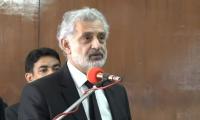In the first part of this article yesterday, we discussed Jamil Jalibi’s foreword to Munshi Sajjad Hussain’s novel ‘Haji Baghlol’. Here we delve deeper into the novel and its characters to see how relevant they appear to Pakistani politics today.
Sajjad Hussain created Haji Baghlol in the late 19th century when the people were longing for some comic relief from their everyday problems. The creator of Baghlol kept the reactions and responses of people in mind, and accordingly shaped the twists and turns of the novel. In this comic serialization, the writer follows two patterns.
One, each chapter or episode is full of action and drama so that people’s interest doesn’t waver and they don’t get bored with iterations of almost the same nature, but with distinct flavour. Two, each chapter, though connected with the past, appears to be independent. The purpose of making each episode dramatic and independent is again twofold: one, the new drama makes people so engrossed that they tend to forget similar chapters from the past. Two, those who have just joined, feel no need to look back to – or read about – the past episodes.
For creators or scriptwriters, it is challenging and critical to keep each chapter comic, dramatic and independent, so that people keep laughing and forget about the seriousness of the issues at hand. If it is not comic and dramatic, people will get serious and sober, resulting in thoughtfulness that may raise questions in people’s minds. The writer may give you some comic relief but does not want to answer questions or engage in a meaningful discussion that may challenge the writer’s own masquerade. The independence or separateness of each episode also serves the same purpose: no connections, no history, no questions.
The same applies to ‘Fasana-e-Azad’, ‘Haji Baghlol’, and even to Dickens’ novels. Now the question is: why do people tend to enjoy such circuses? Perhaps the answer lies not in continuity or technique, but in the emerging dynamics of a character’s follies. The entire novel is based on characters that fool you so much that the plot itself disappears, or the audience is made to forget it. The plot loosely hangs in the background and facilitates the characters to display one act after another; the audience enjoys the colourful nuances of the nonsense.
Now, you may ask: aren’t the novel and its characters unrealistic and exaggerated? Do we see Baghlols in real life? If not, what is so realistic in their behaviour that keeps them alive? Jalibi gives a psychological answer to this. He says, ‘When we are grownup, we tend to ignore or not get impressed by Baghlol-like characters; but when we look back into the days and years gone by, we recall similar characters that we noticed as children. As children our observations are more acute and intense. Children look at adults with impressionable eyes’.
For a scriptwriter, it is important to not let the audience behave like adults or grownups. It is imperative that the audience keep feeling like children, so that they get amused, impressed, and at times lionize some of the characters presented to them. The emotional and internal universe of spectators must be kept in a flux so that they don’t even think of growing up. A constant flux means a constant upheaval that does not allow ideas to settle down. The more settled and at ease you are, the more reflective work you are likely to do.
As a grownup, when you reflect you fail to get impressed by comic characters; at the most you enjoy for a while as a tool of catharsis, but soon you get over it. You see the same characters through different eyes and understanding. With the eyes of a keen observer, you remember that similar chapters and characters have been presented to you earlier; you start making connections and solving the jigsaw puzzle. And this is likely to be a disaster for the scriptwriter, who wants you to keep indulging in the same amnesia, and keep wallowing in each new entertainment.
Azad, Baghlol, Khoji, Nicholas Nickleby, Nusoh, Pickwick, Sancho Panza, Umrao Jaan, or Zahirdar Baig, all have their adventures, with some chapters more serious than others, but human nature is reflected in all of them, and that is the success of literature. All of society is summarized in them with their prominent or not so prominent features. The characters are influenced by events, and the other way round. For example, Haji Baghlol is serious in achieving something, but he is such a single-minded idiot with a high ego and superiority complex that he becomes a laughing stock.
Moreover, Baghlol harbours a misconception about his own capabilities and knowledge. He pretends to be a mister know-it-all, with disastrous results. He becomes a victim of his own absurdities and craziness that he doesn’t realize, but others make fun of. He tries to project himself as a serious and thinking human being, takes pride in his friends, trusts them, but is also prone to flattery and sycophancy. When some people eulogize him for his exceptional abilities, it goes to his head, making him impervious to any sensible advice, unless he is forced by the circumstances.
Baghlol creates a new problem almost every day for himself and for his coteries. When he goes to buy a horse in an auction, he is short-changed. When he falls in love, he is led into a spiritual rigmarole. He is led into one project after another, without knowing an iota about the prerequisites of such ventures. He loves to deliver speeches, and rambles around from one irrelevant point to another. Poor Baghlol simply wanted to be recognized as the most brilliant and outstanding genius of his age, and wanted to offer his services, but fails miserably.
Munshi Sajjad Hussain’s Baghlol wants to do everything, and that too very quickly. He lacks patience and throws tantrums when his wishes don’t come true. His actions and emotions are jumbled up, resulting in a perpetual conflict with his surroundings. His mental contradictions are embedded in his imaginary world which is tainted by his strong likes and dislikes. These conflicts and contradictions become a tragicomedy. Sajjad Hussain created Baghlol to create humour, but this humour is not without pain. The character does become a centre of attention but ultimately feels lonely and the world before him unravels as a dark alley.
Haji Baghlol is a unique character in Urdu literature; he draws sympathy from the readers and gradually the duality of his own personality becomes his nemesis. The writer realizes this and tries to suppress the tragic consequences but the character assumes a life of its own. It is not always in the hands of its creator, rather Haji Baghlol is more influenced by the other characters around him. The writer feels guilty but cannot do much about it, apart from just try to steer clear of his reputation. The more tragic events unfold, the more the writer tries to make it comic and humourous.
Ultimately, in the last chapter, Haji Baghlol blames his friends and foes alike and finally realizes that he is no more able to face the world. He folds his bed, and goes to a faraway place. Here too, the writer tries to make it look funny, but cannot hide the tragic elements of the entire story. Some of Baghlol’s admirers grow up, some refuse to do so, and yet some others look for a new episode that the writer may conjure up.
Concluded
The writer holds a PhD from theUniversity of Birmingham, UK and works in Islamabad.
Email: mnazir1964@yahoo.co.uk
A representational image showing residents walking at a wholesale market in Karachi. — AFP/FileOnce again there is...
A representational image showing late Pakistani human rights activist and Supreme Court lawyer Asma Jahangir. —...
A representational image showing a security personnel sanding guard beside a ship carrying containers at Gwadar port....
A health worker administers polio vaccine drops to a child during a door-to-door polio vaccination campaign in Lahore,...
Armed militants of the banned Tehreek-e-Taliban Pakistan pose for a photograph in Orakzai Agency. —...
An aeroplane of the national flag carrier of Pakistan is seen in this file photo. — AFPWhile Pakistan considers...







